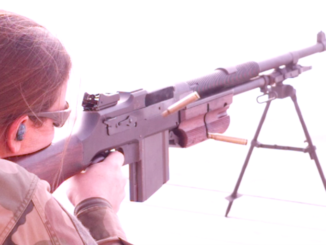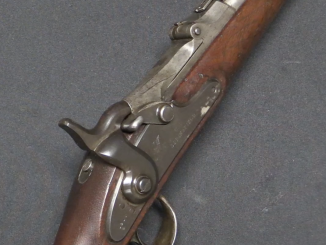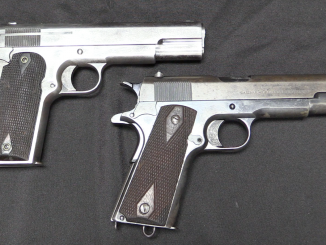The M8C is a .50 caliber self-loading rifle designed to mount on top of the 106mm M40 recoilless rifle. The recoilless rifle creates a massive signature when fired, and so it is imperative that operators move immediately after firing. In order to make accurate first-round hits, the M8C was built with a unique 12.7x77mm cartridge which matches the trajectory of the 106mm round. Using a tracer-spotter projectile, the M40 gunner is able to adjust aim with spotter rounds that will not be noticed by the target and ensure a good hit with the first 106mm shot.
This example has been fitted to a tripod for shooting, which its not historically appropriate – but is convenient.




Yes, touching off the 106mm is going to generate a great deal of attention but it’s also worthwhile bearing in mind the old warning “Tracer points both ways”
The British also used these on their WOMBAT / CONBAT rifles as the ‘Gun Ranging L40A1’.
I had a platoon of eight 106mm M40A1’s with their M8C’s back when I was a LT.
1) Nobody ever seemed to know, not even the oldest sergeants, what made a C model a C model
2) The reason the round is packed in a cardboard sleeve is not because the round is fragile. There is no fuze – impact alone is enough to detonate it. There was a prominent warning in the TM not to remove the sleeve until the round was being loaded into the magazine as if it was dropped and it hit at the wrong angle, it would detonate. What’s the chance of it hitting at the wrong angle? Let me put it this way, Ed Murphy was a West Point grad and a captain at the time he propounded his Law.
“The M48 series consisted of the M48, M48A1 and M48A2. The earlier ones had a primer in the tip, the latter ones used an inert primer as it was found a live primer wasn’t necessary to detonate the spotter compound on impact. The M48 series is not drop safe, nor bore safe, so handle with care.”
3) In addition to the puff of smoke, the spotting round gave off a bright flash when it detonated.
4) We could not fire Annual Service Practice with the 106 at Fort Lewis and had to go to Yakima for that. For practice at home station, we used the M9 30 Cal subcaliber device (expended 106 cartridge case with 30 Cal rifle inserted. The breech was in the base of the cartridge case. https://forums.g503.com/viewtopic.php?t=291455). For longer ranged practice, we used the spotting rifle as a subcaliber device.
5. In the last several years, I have seen pictures of M40A1’s with M8C’s being used in Syria https://www.wired.com/2013/05/ancient-us-weapon-in-syria/
6. The British adopted the M8C for use on their 120mm WOMBAT (Weapon Of Magnesium Battalion Antitank) the BAT had an optical sight, the MOBAT used a Bren as a spotting gun, when converted to use the M8C, the later two became the CONBAT (Converted Battalion Antitank)
https://www.tanks.net/anti-tank-weapons/united-kingdom-l6-wombat-120mm-recoilless.html
I don’t know whether the 106 and 120 trajectories were similar enough that one spotting round could be serve for both or whether the British brewed up a special round for the 120
L2 BAT, Battalion Anti Tank
The original towed gun complete with a heavy armoured shield and wheeled mount. Accepted for service in 1953.
L4 MoBAT (Mobile BAT)
A BAT with the shield removed to lighten it (even though it still weighed some 770 kg (0.76 long tons) and a spotting weapon (a Bren light machine gun) added. It could be towed by an Austin Champ or, later, a Land Rover.
L6 WOMBAT
A new build weapon with a lightweight carriage, which meant that it was usable by all air Mobile (Infantry Battalions) plus mobile troops, such as the Parachute Regiment and Royal Marine Commandos. It was also fitted to vehicles, such as the FV432 or a 3/4 ton portee Land Rover. When fitted with an M8C .50 cal spotting rifle, which fired a zirconium-tipped spotter tracer round visible past 2,000 yards, it could engage targets out to 2,000 m (2,200 yd). The strike was observed by the No. 1, who called the fall of shot. The No. 2 maintained the spotting rifle and observed the back blast area. The WOMBAT entered service in 1964, rapidly replacing earlier versions in service with the regular army; but it never fully replaced MOBAT and CONBAT with infantry units of the Territorial Army.
L7 CONBAT (“Converted BAT”)
A conversion of the L4 MoBAT or L2 BAT utilizing a L40A1 12.7 mm spotting rifle. (The American designation was the .50-cal M8C spotting rifle. It used a shorter cartridge than the .50-cal machine gun.)
Very good information in your post. Thanks. I do have to point out however, that you fell for WOMBAT being an acronym having to do with magnesium. That’s actually a ‘backronym’ that didn’t appear before 1991.
Oh, and I believe you’ll find that Edward Murphy was a Major by the end of WW2.
Fantastic post, Col Beausabre. Thank you for your efforts (and for your service).
Can you tell us whether your spotting round was actually triple tracer as Ian says and also what the load out proportion of spotting rounds to main gun rounds was? Cheers
I remember seeing these mounted on ONTOS tracked vehicles.
A lightweight tracked vehicle that could bring a lot of hate very quickly – 6 shots before you have to get out and reload, as well as render aid to whatever infantry you were supporting that ended up behind you when you unleashed the hate. The Marines used it in Vietnam, I believe.
“(…)Marines used it in Vietnam, I believe.(…)”
Yes https://www.tanks-encyclopedia.com/coldwar/US/M50_Ontos.php though rarely in its supposed role of tank destroyer, more often as direct support (using HE and shrapnel) or to knock on walls and blockhaus with ease.
For reasons behind my comprehension it was named in Greek, despite its’ development was not linked with Hellenic forces as far as I know.
JGSDF used somewhat similar vehicles but with just 2 guns, dubbed Type 60 https://www.militaryfactory.com/armor/detail.php?armor_id=322
My personal theory is they named it the Ontos (Thing) as in “what the hell is that Thing?”
Fort Knox, NCO School, April 1969. The M151A1C, a jeep mounting a 106mm recoilless rifle was still the mainstay of the anti-tank platoon. A top-heavy arrangement that exacerbated the M151s well documented reputation for overturning accidents. The backblast was fierce and as you mentioned made your position very apparent, so a first round hit was desired. Regardless, “If you ever give a m*** F*** your best shot, don’t hang around to see how it turns out.”
Interestingly French toyed with combining their off-road version of 2CV with 75 mm recoil-less https://tanks-encyclopedia.com/2cv-ghan1/
they found that it is not entirely recoil-less and does damage suspension, so they switched to MG 151/20 which could lift wheels when firing broadside (see photos in linked article)
Wonderfully simple design. I could imagine a miniature version of that action as the basis for a semi-automatic shoulder rifle.
Had they made a version of the M8C with a grip and shoulder stock, they would have had an anti-material rifle before Barrett’s Light-50. IMHO of course.
Well, consider apt list of Users of M40 https://weaponsystems.net/system/1341-106mm%20M40
The M40 was used by the United States military and most European nations. Most have been replaced by guided missiles, making the M40 very uncommon in Western nations. The M40 remains in widespread use in Asia, Africa, the Middle East and South America. With the introduction of anti-tank missiles the M40 is often relegated to a secondary role and nowadays is mostly used as a support weapon for infantry operations.
I would not be surprised if someone did reworked M8C to use as standalone weapon.
From similar adaptation PG-14.5 NIGHT PREDATOR https://www.thefirearmblog.com/blog/2021/08/20/ukrainian-pg-14-5-night-predator-anti-materiel-rifle/ was spawned by 2X35 Inserted Unified Self-loading Gun which is mounted inside tank barrels for training purposes. It uses standard 14,5×114 cartridge.
“(…)12.7x77mm cartridge(…)”
This cartridge has also peculiar inside construction, see 1st photo from top
https://cartridgecollectors.org/cmo/cmo08dec.htm
note channel between primer and center of powder.
LAW80 also used own spotting rifle, which also used cartridge of peculiar construction known as 9 x 51 SMAW see https://forum.cartridgecollectors.org/t/law80-and-repeating-spotting-rifle-9×51/40180/4
Front ignition is common in artillery
In ordinary rifle size cases, it has been tried, although the difficulty and expense of installing the tubes and in loading and re-loading the cases is a deterrent to widespread adoption.
There’s an article about using “Rocky” Gibbs techniques for front ignition in a 7mm Remington mag case,
Author was Stan Skinner, it was published as pages 482 to 486 in Barnes, cartridges of the world, 10th edition.
Advantages claimed are much greater consistency of ignition, pressure and velocity, and less throat erosion.
Apparently combustion and heat are better confined to the case
Would that Rigel fire a standard 50 cal round?
If you mean 12,7×99 mm NATO by “standard 50 cal” then definitely not.
Cartridge for this weapon was substantially smaller (shorter)
https://naboje.org/node/4618
therefore chamber is too small for 12,7×99 mm NATO cartridge.
I wonder if there are any recorded kills with the M8 alone?
I remember this system from FT Riley, KS back in 1973. I underwent orientation on the M40 and expended three .50 cal rounds before I was on target (a wrecked car). When the 106 round hit, it apparently ignited some gasoline vapor or something else which was volatile because the car body flashed, then lifted off the ground.
Thank you for your presentation Ian. And thank you as well Colonel. I always enjoy the comments of a real soldier.
I used to work with a guy who was former crew of one of the 106 teams. Since they were a direct fire weapon, they got to move to the front of the line on fire practice days. He said they always hoped the 105 & 155 guys were having good days. Esp since their shells would be passing over the 106 crews & their jeeps on the way to the impact area.
A 106mm reckless spotting round serves well for a .50 cal antimaterial rifle. You can aim for the hole it makes.
M8Colibri – The ‘C’ designation came about when the tri-color tracer began being used. One of the French ballisticians stated that the multicolored plume reminded him of the hummingbirds around his hometown. Hummingbird in French = Colibri. All M8s were quickly stamped with a C in honor of the ballistician who of which, no one could remember his name.
Or….I just made all that up.
I’m impressed. 24 hours in and no diatribes about how the Germans/Russians did it better or questioning Renee Studler’s parentage.